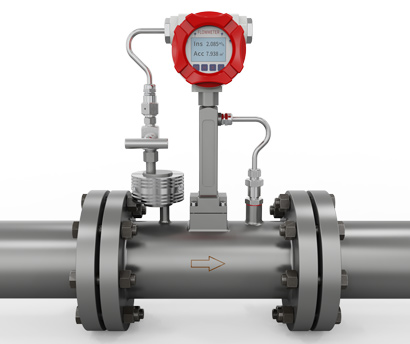涡流测量误差的主要来源
Vortex flowmeter in the measurement process may appear error, these errors mainly from the following aspects:
安装条件
- 1. Insufficient front and rear straight pipe sections: vortex flowmeter is sensitive to the flow state, if the length of front and rear straight pipe sections is insufficient, it will lead to unstable fluid flow and produce measurement error. Usually the length of the front straight pipe section is 10D-15D (D is the diameter of the pipe), and the length of the back straight pipe section is 5D.
- 2. Pipeline vibration: vortex flowmeter sensitive to pipeline vibration, vibration may lead to sensor error detection vortex signal, thus generating errors.
- 3. Installation misalignment: flowmeter and pipe misalignment will lead to uneven fluid flow, affecting the measurement accuracy.
Fluid characteristics
- 1. Changes in fluid state: If air bubbles or solid particles are present in the fluid, they may interfere with the generation and detection of vortices, leading to measurement errors.
- 2. Changes in fluid viscosity: High viscosity fluids can affect the frequency of vortex generation, thus affecting measurement accuracy.
- 3. Temperature and pressure changes: Changes in the temperature and pressure of the fluid may lead to changes in density and viscosity, which in turn affect the measurement results.

The flowmeter itself
- 1. Wear and tear of the vortex generator: after long-term use, the vortex generator may wear and tear, leading to changes in the vortex frequency and affecting the measurement accuracy.
- 2. Sensor sensitivity degradation: aging or contamination of the sensor may lead to inaccurate signal detection, resulting in error.
- 3. Electronic components drift: flowmeter internal electronic components (such as amplifiers, signal processors, ETC。) may be due to temperature changes or aging drift, affecting the measurement accuracy.
Environmental factor
- 1. Electromagnetic interference: strong electromagnetic fields may interfere with the signal transmission and processing of the flowmeter, resulting in measurement errors.
- 2. Temperature changes: changes in ambient temperature may affect the stability of the flowmeter electronic components, which in turn affects the measurement accuracy.
Operation and maintenance
- 1. Parameter setting error: flowmeter parameter settings (such as pipe diameter, fluid density, ETC。) if the actual working conditions do not match, will lead to measurement errors.
- 2. Insufficient maintenance: long-term calibration or maintenance, may lead to flowmeter performance decline, errors.
流范围
- 1. Low Flow Measurement: Under low flow conditions, the vortex signal is weak, which may lead to inaccurate detection and large errors.
- 2. High Flow Measurement: Under high flow conditions, fluid flow may become unstable, affecting measurement accuracy.

信号处理
- 1. Signal noise: Noise in the fluid flow may interfere with the detection of the vortex signal, leading to measurement errors.
- 2. Signal processing algorithm: The signal processing algorithm of the flowmeter may lead to measurement error if it is not precise enough.
Pipe size and shape
- 1. Pipe size mismatch: If the pipe size of the flowmeter does not match the actual pipe size, it will lead to uneven fluid flow and affect the measurement accuracy.
- 2. Pipe shape irregularity: non-circular pipes or pipes with protrusions (such as welds, flanges, ETC。) may lead to unstable fluid flow, resulting in errors.
Calibration issues
- 1. Inaccurate calibration: flowmeter in the calibration process if there are errors, will lead to errors in the actual measurement.
- 2. Calibration cycle is too long: a long period of time without calibration may lead to a decline in the performance of the flowmeter, resulting in errors.
Measurement errors in vortex flowmeters arise mainly from installation conditions, fluid characteristics, the meter itself, environmental factors, operation and maintenance, flow ranges, signal processing, pipe size and shape, and calibration issues. In order to reduce the measurement error, it is necessary to:
- 1. Ensure that the installation conditions meet the requirements (e.g., length of straight section before and after, pipe alignment, ETC。).
- 2. Select a flowmeter model suitable for the fluid characteristics.
- 3. Perform regular calibration and maintenance.
- 4. Avoid environmental disturbances (e.g. vibration, electromagnetic interference, ETC。).
- 5. Take appropriate compensation measures under low and high flow conditions.
By comprehensively considering these factors and taking corresponding measures, the measurement accuracy and reliability of vortex flowmeter can be effectively improved.


